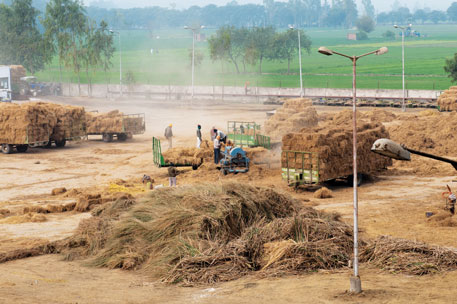Technology For Getting Power From Municipal Solid Waste / Stubble (Parali)
Today, Municipal Solid Waste and “Parali Burning (stubble burning)” has become a big problem for all states and for our Nation itself.
Gasification technology is the most effective technology for setting up small power plants. With this technology. MSW (after segregation) is fed into the Gasifier, which results in the production of Producer Gas, which is fed into the gas engine to produce electricity. The gas can also be used for the replacement of Petro Fuels in Furnaces and Industrial Kilns.

Chanderpur Group (CPG), Yamuna Nagar, Haryana, is a manufacturer of Municipal Solid Waste gasifier systems, having a capacity 40Kg/Hr to 1200 Kg/Hr (on RDF) and can supply such types of plants up to 100 TPD. This is an excellent technology for Industries, Resorts, Banquet Halls, Small towns, and Villages. The Group is manufacturing gasifiers for the last 15 years under technical collaboration with TERI, New Delhi, and supplied the gasifiers in India as well as to the USA, Romania, Canada, Slovakia, Finland, United Kingdom, Thailand, Guyana, South Africa, Rwanda, etc.
CPG is also doing R&D and successfully tried the use of Parali and RDF in biomass gasification, which is working successfully. CPG believes that we should go for the decentralized plants.in cities, villages, and towns, instead of big plants. The advantage of decentralized plants is:
- These are small-budget projects and can be put by local entrepreneurs, so it creates entrepreneurship and employment.
- It has also been observed that at the house level, the garbage is well segregated. Ladies keep the waste separated i.e., kitchen waste, plastic waste, metal waste, etc. and they are concerned with its cost. So generally, they sell metals to local kabaddi (Ragman) and send the balance of waste in the garbage. It is the municipal corporation, which does not have a separate vehicle to take separate garbage. They put all the garbage in one truck and dump it into a dumping site, where it becomes a difficult task to segregate it. If small plants (a combination of gasification + bio-methanation unit) will be put up in different localities, then the entrepreneur will arrange to take garbage in a separate vehicle and take it straight to the power project and use kitchen waste in the bio-methanation plant and dry waste in gasifier plant. As these plants will be set up in different areas by different entrepreneurs, they can educate that locality for the above tasks.
- Only one segregation plant will be required at one place in a city, where garbage from markets, roads, and other common places can be dumped, segregated, and then shredded & bailed and can be used/sold.
We feel it will take some years to educate the Indian public to throw garbage in separate dustbins in a public place i.e., Dry/wet/metal/glass dustbins. Presently no separate dustbins have been provided. The garbage is again mixed while lifting from the house doors / other places. So, with the passage of time and the installation of these small gasification/ bio-methanation plants, the public will become aware of the advantage of keeping the waste separate.
Nowadays big plants are proposed (i.e., from 600TPD to 1000TPD), which involves huge fund outlay and can be put up by big companies or international players, who are not very much interested in putting these plants in India as these are uneconomical (due to low tipping fees paid by the municipal corporation and also due to low electricity tariff). Banks are not interested in financing these plants as, so far, all these types of plants are not running well.
These small plants being 100% made in India, run by the local people, fulfill all three dreams of our Hon’ble Prime Minister i.e., “Swachh Bharat”, “Make In India” and “Skill India”
India has a huge requirement for such types of small plants, due to its higher population. So, we feel if we start the journey with small, decentralized plants, then, with the success of these small plants, at the later stage, we can move to the bigger projects. It is a similar case of the “Sugar Mills”. 40 years before Sugar Mills were installed at the capacity of 600TPD. Nowadays new sugar plants are put up with a capacity of 10,000 TPD, as now logistics, entrepreneurship, and funding are available for Big projects. A similar story can be replicated for waste management projects.
In this way, through Gasification Technology, we can solve the problem of MSW from our state/country.

